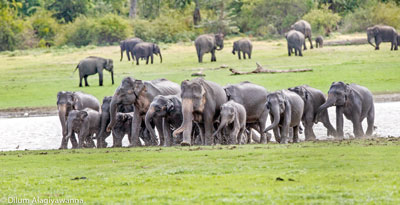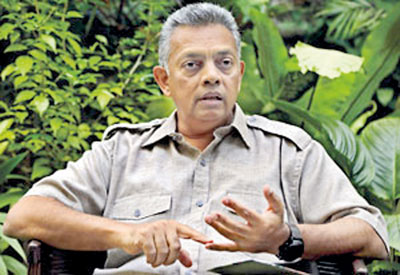News
Working in tandem for the good of both humans and wild elephants
It is a good example of politicians and bureaucrats working in tandem with conservationists, to bring about what is best for people and wildlife, without jeopardizing development.

Minneriya’s ‘Elephant Gathering’. Pic courtesy of conservationist-photographer Dilum Alagiyawanna
Like the extraordinary Gathering of Elephants at Minneriya, a wildlife event which draws wonder, the coordination among bureaucrats under the direct guidance of President Maithripala Sirisena, consultants and conservationists, is being hailed by many.
This has led to the adjustment of the diversion plan linked to the Minneriya tank under the Mahaweli Water Security Investment Programme, without harm to the farmers or wild elephants.
“We have changed the diversion plan to safeguard the annual elephant gathering at the Minneriya/Kaudulla National Parks,” Mahaweli Development and Environment Ministry Secretary Anura Dissanayake had announced at a workshop of all stakeholders after extensive discussions last Wednesday (September 26) at the Sri Lanka Foundation Institute.
Earlier, the plan had been to send water to the Minneriya tank from Kalinga Nuwara, whenever the levels of the Minneriya tank dropped. The Minneriya tank feeds Kaudulla tank through a cascade system.
However, a win-win situation has now come about for both farmers and wild elephants, under a revised plan to pump water from the Jana Ranjana pumping station directly to the Kaudulla tank, ensuring that the Minneriya tank would retain its existing water-level variation patterns, coming down from centuries, the Sunday Times learns.
If the original diversion plan was implemented, it would have posed a major threat to The Elephant Gathering.
Spending much time at Minneriya and Kaudulla, studying and observing wild elephants, former Director-General of the Department of Wildlife Conservation (DWC) and conservationist, Dr. Sumith Pilapitiya and conservationist-photographer, Dilum Alagiyawanna had felt it was their duty to bring their knowledge to the attention of the Mahaweli Development and Environment Ministry, when the original diversion plan was drafted. This ministry portfolio is held by President Sirisena.
Dr. Pilapitiya and Mr. Alagiyawanna were armed with evidence including the latter’s film on ‘The Great Elephant Gathering of Asia’ which had won the ‘Best Animal Behaviour Award’ at the 13th Japan Wildlife Film Festival held in Tokyo, Japan in April this year.

Dilum Alagiyawanna
Open to different views, more than 50 officials including Mr. Dissanayake and also the consultants who had drawn up the diversion plan had been riveted by the film screened for them at the Tharanganee cinema of the National Film Corporation on August 28. President Sirisena had also seen a special screening on August 22.
Thereafter, Secretary Dissanayake had appointed a 12-member committee including officials and other stakeholders such as the Irrigation Department and the DWC to look into the matter, with an observer from the Wildlife and Nature Protection Society (WNPS).
They had studied all aspects including water-level variations at the Minneriya tank over a 45-year period, before making suggestions for the adjustment of the original plan.
Dispelling a popular misconception that the main reason why wild elephants gather on the Minneriya and Kaudulla tank-beds is the availability of water during the dry season, Dr. Pilapitiya says that water is not the primary reason. The elephants come for the fodder they get from the grasslands, with water being a secondary reason.
In his precise and concise manner, Dr. Pilapitiya says: “Both Minneriya and Kaudulla tank-beds get fully submerged during the northeast monsoon and remain so for about 3-4 months. During this time, the grass on the tank-beds dies. However, with the release of water from the tanks, the tank-beds get gradually exposed. Due to nutrient-rich sediments deposited on the tank-beds during the period of inundation, a growth of new and succulent grass emerges on the exposed tank-beds.
“This new grass is high in protein content and is the most preferred food of elephants. The new grass in large quantities on the tank-beds is the main attraction for the elephants of the gathering.”
According to him when there is food aplenty, elephants like to congregate in large numbers for social interaction. This is the main reason for large herds, often exceeding 100 elephants, to be a common feature at Minneriya and Kaudulla during the dry season, giving rise to this phenomenon being called the Great Elephant Gathering.
“However, to ensure the continuance of the Great Elephant Gathering at Minneriya and Kaudulla, the ecosystem dynamics must remain the same,” urges Dr. Pilapitiya, stressing that the grasslands of the tank-beds must get submerged for 3-4 months, after which there should be slow exposure of the tank-beds for the growth of fresh grass for 7-8 months.

Dr. Sumith Pilapitiya
Talking in figures, he says that when the Minneriya tank/reservoir is full, it has a storage capacity of 135 MCM, but reduces to 35 MCM during the height of the dry season. However, if the “submergence” and “emergence” of the grasslands do not occur and there is a section of the tank-bed exposed year-round, it would not be adequate to support the 300-400 elephants of the Minneriya and Kaudulla population.
“Grasslands exposed year-round contain mature grass. While new grass is high in protein and is in high demand by elephants, in contrast, mature grass contains high contents of fibre and silica, with very low to no protein content. Elephants, while consuming mature grass, have a lower preference for it. Then they will tend to go in search of other options of fodder, often moving to croplands,” he explains.
Citing the failure of the northeast monsoon over the last two years, Dr. Pilapitiya is quick to point out that neither Minneriya nor Kaudulla tanks got filled up to capacity.
Large sections of the grasslands on the tank-beds did not get submerged. As such, the grass was mature, especially in 2018. This resulted in a lower elephant presence, of only about 200, in Minneriya and Kaudulla and a significant increase in the Human Elephant Conflict (HEC), with increased crop raiding compared to previous years. This is clearly shown by DWC data.
“This is why the ‘submergence’ and ‘emergence’ of the Minneriya and Kaudulla tank-beds should continue,” is Dr. Pilapitiya’s appeal.
Tackling another common misperception that elephants like primary forest as their habitat, he says that scientific research has shown that the elephant density in primary forests is 0.2 elephants per square km, while the density of elephants in grasslands is 3 elephants per square km. This is a clear indication that to support the Minneriya and Kaudulla elephant population, large expanses of grasslands would be needed.
“Attempting to create such grasslands within forests will be futile because experience has shown that creating and maintaining new grasslands are virtually impossible.
Therefore, the grasslands of Minneriya and Kaudulla reservoirs cannot be submerged permanently,” says Dr. Pilapitiya, next turning the focus on the revenue earned by Sri Lanka through tourism.
If the country wishes to continue receiving the revenue stream of Rs. 1.5 billion per year to the economy from direct and indirect tourism benefits from the Great Elephant Gathering as well as conserve this elephant population, we need to ensure that the cycle of submergence and emergence of the tank-beds is not disrupted, he adds.
Mr. Alagiyawanna too echoes the sentiments expressed by Dr. Pilapitiya.
Minneriya’s Gathering of Elephants is among the Top 10 ‘Greatest Wildlife Spectacles’ listed by Lonely Planet which includes only two from Asia, the other being Sarawak’s ‘Bats of Deer Cave’.
Meanwhile, Mr. Alagiyawanna is happy that his documentary film ‘The Great Elephant Gathering of Asia’ produced under the self-initiative philosophy of Films for Conservation was instrumental in convincing the ministry to take another look at the proposed Mahaweli Water Security Investment Programme.

